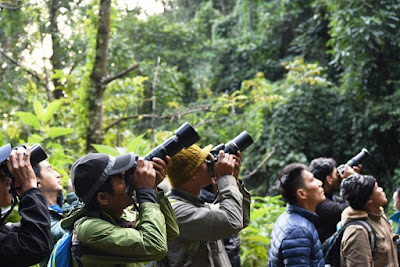Birdwatching
tourism or avitourism is a form of nature based ecotourism that deals to travel and tourism for observing and
identifying birds in their natural habitats. It is one of the fastest growing
outdoor activity around the world and particularly gaining popularity in
developing countries. Birdwatchers are mostly conservation-minded responsible
ecotourists, respect wildlife and natural habitats and have above average
incomes1. As per economic assessment study the annual economic value
of bird watching tourism industry in United States is around $107 billion and United
Kingdom birdwatching expenditures are estimated at $500 million per year. Birdwatching
tourism opens potential remote areas for birdwatchers and also provides economic
motivation to local community for conservation of bird species and natural
habitats.
Birdwatching tourism in Gaoligongshan
National Nature Reserve, China
Arunachal
Pradesh is recognized as one of the 25 mega biodiversity hotspots of the world
with the second highest breeding bird diversity in the world2. It is
largest mountain state (83,743 km2) of North East Region of the country,
having 80% forest cover and considerable area (around 11.82 % of geographical
area of the state) under protected area network (PAN). There are 2 National
Parks, 11 Wildlife Sanctuaries, 1 orchid sanctuary, 2 tiger reserves, 2
elephant reserves and 1 biosphere reserve in the state. The state has an
exceptional richness in avian diversity, around 750 birds species have been
recorded from the state (57 % of total avian species of country), making the
state second highest avian diversity state in the country3,4. There are
25 notified Important Bird Areas (IBA) in the state. Arunachal Pradesh is not
fully explored in ornithological perspective and holds great potential for new
bird species discoveries5. Some new bird Species such as Himalayan
Forest Thrush (Zoothera salimalii), Bugun Liocichla (Liocichla
bugunorum) and new subspecies of the Sclater’s monal (Lophophorus
sclateri arunachalensis) have recently been recorded from the state. Diverse
landscapes and varied climatic conditions also offer suitable habitats of
various migratory birds viz. Black-necked Crane (Grus nigricollis), Ruddy
Shelduck (Tadorna ferruginea), Spot-billed pelican (Pelecanus
philippensis), Anas Spp. Arunachal Pradesh has the highest diversity of
hornbills in the country, as it is home to five different species (out of 9
species recorded from India) namely Great Hornbill (Buceros bicornis),
Rufous-necked Hornbill (Aceros nipalensis), Wreathed Hornbill (Rhyticeros
undulates), White-throated Brown Hornbill (Anorrhinus austeni) and
Oriental Pied Hornbill (Anthracoceros albirostris). Rich and unique bird
diversity of state makes it a very idle destination of birdwatchers. Eaglenest
Wildlife Sanctuary (454 avifauna), Namdapha National Parks (491 avifauna), Pakke
Tiger Reserve (282 avifauna), Mouling National Park (114 avifauna), Dehang
Dibang Biosphere Reserve (153 avifauna), Tawang area (113 avifauna) and Talle
Valley Wildlife Sanctuary (130 avifauna) are some of the potential birdwatching
areas of the state.
Migratory
Rudy Shelduck (Tadorna ferruginea) at Shungaster lake,
Tawang
Author has recently
participated in a regional workshop on harnessing potential on birdwatching ecotourism
under Landscape Initiative for the Far-Eastern Himalayas (HI-LIFE) project
organized by International Centre for Integrated Mountain Development (ICIMOD),
Nepal in Baihualing village of Yunnan, China and observed that villagers of Baihualing
have successfully promoted the birdwatching tourism. Now this village has
become a popular destination for international and national birdwatchers due to
its close proximity to Gaoligongshan National Nature Reserve (GNNR) and the
rich diversity of bird species. The local community are directly getting
livelihood benefits from homestay operation, food, transport, bird watching
ponds & hides, bird guide services and selling of local products and
souvenir. They are also actively involved in various bird and nature
conservation activities.
Considering the
rich diversity of birds and presence of important bird areas in Arunachal
Pradesh, there is ample opportunity for development of birdwatching tourism in
the state therefore such community driven birdwatching ecotourism initiative
needs to be implemented in the state. This will provide alternative livelihood
opportunity to local community and will also reduce pressure on the forest and
natural resources and ultimately help in conservation of biodiversity. It could
also be one of the climate change mitigation and adaptation strategy for this
climate change sensitive Himalayan state6. At present, Bugun community is involved in
birdwatching tourism activity in Eaglenest Wildlife Sanctuary of the state but,
there is huge potential for development of birdwatching tourism sector in the other
areas of state. Collaborative actions and wider partnership of all stake
holders mainly forest and tourism departments, research institutions,
researchers, non government organization (NGO), tourism sector organizations
and community are urgently need to harness the birdwatching tourism potential
of the state. Capacity building and awareness creation among local community
are other important priority areas for sustainable development of community
based birdwatching tourism in Arunachal Pradesh.
References:
1. Sekercioglu,
C.,Impacts of birdwatching on human and avian communities. Environ Conserv.,
2002, 29, 282–289.
2. Mohan, D. and Athreya, R., Sustainable bird based tourism in India's remote north-east frontier. International Journal of Innovation Science, 2011, 3, 23–28.
3. Chowdhury,
A. U., A pocket guide to the birds of Arunachal Pradesh. 1st ed. Gibbon Books,
Guwahati, 2006.
4. Mize,
D. and Tsomu, T., Avi-fauna species recorded from the Rono Hill of Arunachal
Pradesh. The Ecoscan, 2012, 6,177-180.
5. Mishra,
C. and Datta, A., A new bird species from eastern Himalayan Arunachal Pradesh-
India’s biological Frontier. Current Science, 2007, 92(9), 1205-1206.
6. Kanwal,
K.S., et al., Climate change and high-altitude wetlands of Arunachal
Pradesh. Current Science, 2013, 105 (8), 1037-38.







Kasvava metsa müük tähendab seda, et müüakse ainult metsamaal kasvavat täiskasvanud metsa, s.o õigust raiuda metsa. Pärast raietöid ja metsamaterjali müüki jääb metsamaa metsaomanikule.
ReplyDeleteMetsa raie on viimastel aastatel metsaomanike poolt üha enam tähelepanu pälvinud, kuna hakkpuidu tootjate ja tarbijate arv kasvab. Metsa ABC müüb hakkpuitu otse hakkpuidu tootjatele, mis võib olla oodatust tasuvam, kuna ainsana maksavad hakkpuidutootjad reaalset turuhinda.
ReplyDelete